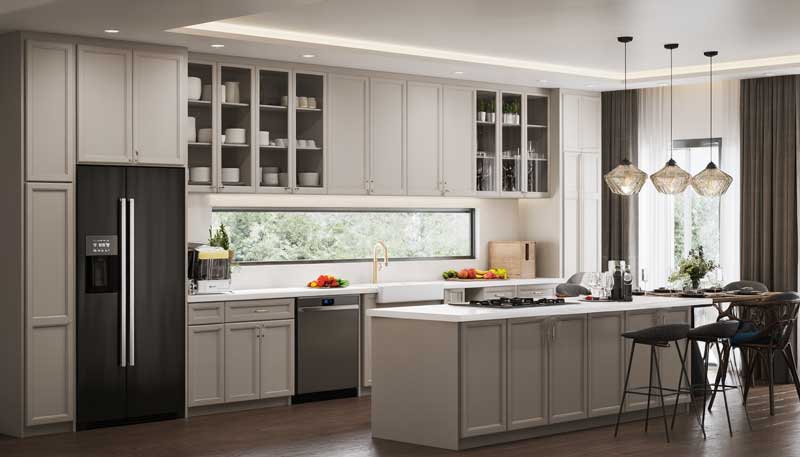Kitchen ➢ Kitchen Efficiency
How to Create the Ultimate Efficient Kitchen Setup

An efficient kitchen isn't just about having the latest gadgets—it's about creating a workspace that minimizes effort while maximizing results. The most effective kitchen setups combine smart design principles with carefully chosen tools that work together to streamline every aspect of food preparation, cooking, and cleanup.
Whether you're working with a spacious kitchen or a compact space, the principles of efficiency remain the same: minimize movement, maximize accessibility, and create logical workflows that make cooking faster and more enjoyable. Smart technology can enhance these principles but should never complicate simple tasks.
The Work Triangle and Modern Workflow Design
The classic work triangle connecting sink, stove, and refrigerator remains relevant, but modern efficient kitchens expand this concept to include prep areas, storage zones, and cleanup stations. The goal is creating smooth pathways between related tasks without backtracking or cross-traffic.
Consider your cooking style when designing workflow. If you frequently prepare complex meals, you'll need more counter space and staging areas. If you focus on quick meals, prioritize easy access to frequently used tools and ingredients. The most efficient layout is one that matches your actual cooking patterns.
Smart kitchen islands or carts can create additional work zones and storage while maintaining flexibility. Mobile prep stations allow you to bring tools and ingredients to where you need them rather than constantly moving between fixed locations.
Strategic Storage and Organization Systems
Efficient storage places the most frequently used items in the most accessible locations—typically between waist and shoulder height. Reserve hard-to-reach areas for items used occasionally, and keep daily essentials within easy reach of their primary use areas.
Drawer organizers and pull-out shelves maximize accessibility and visibility. When you can see everything at a glance, you waste less time searching for tools and ingredients. Deep drawers often work better than cabinets for storing pots, pans, and small appliances.
Smart storage solutions include magnetic knife strips, hanging pot racks, and inside-cabinet door organizers that make use of previously wasted space. The goal is having a designated place for everything and keeping everything in its place.
Essential Tools and Multi-Function Equipment
Focus on high-quality, versatile tools rather than numerous single-purpose gadgets. A good chef's knife, cutting board, mixing bowls, and measuring tools form the foundation of an efficient kitchen. Choose tools that can handle multiple tasks to reduce clutter and complexity.
Smart appliances should genuinely improve efficiency rather than just adding features. A programmable slow cooker, multi-function pressure cooker, or high-quality food processor can replace multiple single-purpose devices while producing better results.
Consider the maintenance and storage requirements of any tool or appliance. Equipment that's difficult to clean or store properly will eventually become unused clutter rather than efficiency aids.
Prep and Staging Area Optimization
Dedicated prep areas with proper lighting, cutting boards, and tool storage dramatically improve cooking efficiency. Having everything needed for food preparation in one well-organized zone reduces movement and setup time for each cooking session.
Multiple cutting boards designated for different food types prevent cross-contamination while allowing continuous prep work. Consider boards that fit over sinks or can be stored vertically to maximize counter space when not in use.
Prep containers and staging bowls allow you to prepare all ingredients before cooking begins, following the professional "mise en place" approach that makes cooking smoother and reduces errors.
Smart Lighting and Environmental Controls
Proper lighting is crucial for efficient and safe cooking. Task lighting over work areas, under-cabinet lighting for countertops, and ambient lighting for general kitchen use create a functional environment that reduces eye strain and improves accuracy.
Smart lighting systems can adjust automatically based on the time of day and cooking activities. Bright, cool light for detailed prep work, warm light for dining, and dimmed lighting for cleanup can all be programmed into automated sequences.
Climate control affects comfort and food safety. Proper ventilation removes cooking odors and heat while maintaining air quality. Smart ventilation systems can adjust automatically based on cooking activity and outdoor conditions.
Cleanup and Maintenance Efficiency
An efficient kitchen makes cleanup as easy as cooking. This means having cleaning supplies accessible, adequate counter space near the sink, and systems that prevent messes from accumulating.
Dishwasher placement and loading strategy can significantly impact cleanup efficiency. Position the dishwasher near the sink and main prep areas, and organize dishes and utensils to make loading and unloading faster.
Daily maintenance routines—wiping surfaces as you go, washing cutting boards immediately after use, and putting tools away promptly—prevent small tasks from becoming time-consuming problems.
Technology Integration for Enhanced Efficiency
Smart kitchen technology should integrate seamlessly with your workflow rather than requiring separate attention. Voice-activated timers, smart scales that sync with recipe apps, and appliances that can be preheated remotely all save time without adding complexity.
Inventory management systems help maintain efficient shopping and meal planning. Smart pantry organization and expiration date tracking reduce food waste while ensuring you have necessary ingredients when needed.
Personalizing Your Efficient Kitchen
The most efficient kitchen setup is one that matches your specific cooking habits, physical needs, and lifestyle. Observe your current cooking patterns to identify inefficiencies, then address the most time-consuming or frustrating aspects first.
Start with small improvements that provide immediate benefits—better knife storage, improved lighting, or reorganized frequently used items. Build on these successes gradually rather than attempting a complete kitchen overhaul at once.
Remember that efficiency should enhance the enjoyment of cooking, not turn it into a sterile process. The goal is creating a kitchen that makes cooking easier and more pleasant, allowing you to focus on the creative and social aspects of food preparation.
Share this article:
React to this article: